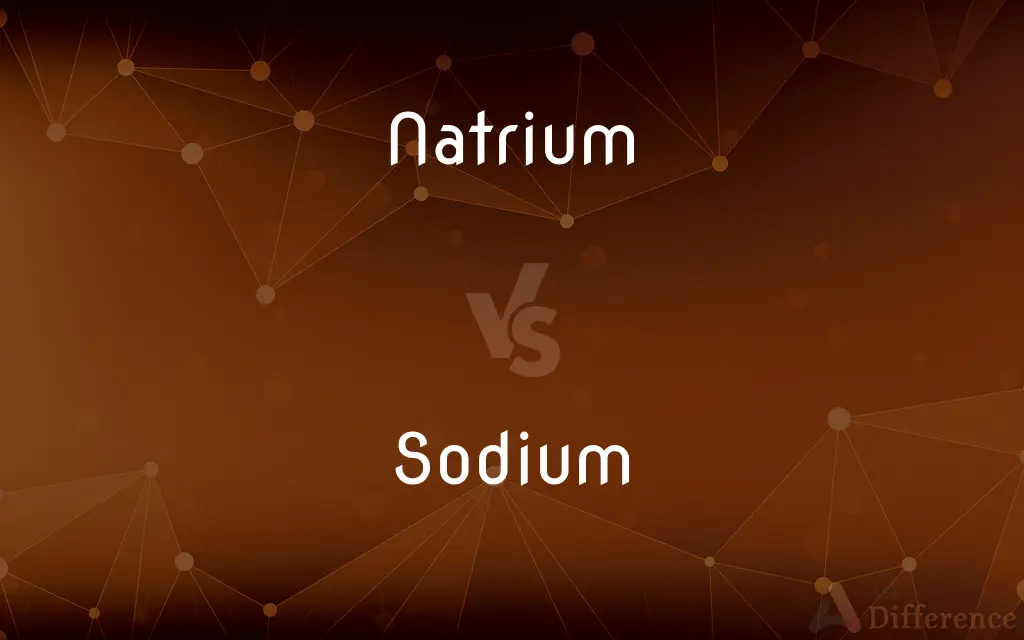Natrium vs. Sodium — What's the Difference?
Edited by Tayyaba Rehman — By Fiza Rafique — Updated on September 30, 2023
"Natrium" is the Latin name for the element known in English as "sodium." Both refer to the same chemical element, but the term "sodium" is more commonly used in English.

Difference Between Natrium and Sodium
Table of Contents
ADVERTISEMENT
Key Differences
"Natrium" and "sodium" are terms that refer to the same chemical element, Na, which is essential for many biological processes in organisms. While "natrium" hails from the Latin origin and is the term from which the elemental symbol "Na" is derived, "sodium" is the English adaptation of the element's name.
The discovery of "natrium" or "sodium" is credited to Sir Humphry Davy in 1807. While the word "natrium" pays homage to the element's historical roots, the term "sodium" has become more familiar in the English-speaking world, especially in the contexts of nutrition, chemistry, and medicine.
"Natrium" might still be encountered in languages other than English, reflecting the historical nomenclature of the element. In contrast, "sodium" has been embraced in English and is the term you'll most often encounter, especially when discussing topics like sodium chloride (table salt) or dietary sodium intake.
Comparison Chart
Origin
Latin
English
Symbol in Periodic Table
Na
Na
ADVERTISEMENT
Common Usage
Rare in English, more common in some European languages
Predominant in English
Context
Historical and linguistic
Scientific, dietary, medical
Example Compound
Natrium chloride
Sodium chloride
Compare with Definitions
Natrium
Name rooted in ancient methods of obtaining sodium.
Natrium connects us to historical practices in chemistry.
Sodium
Essential mineral in the human diet.
Sodium intake is often linked with blood pressure levels.
Natrium
Historical name for sodium in various languages.
Some European countries still use Natrium on their food labels.
Sodium
Used in various industries beyond nutrition.
Sodium vapors are used in some types of street lights.
Natrium
Origin of the elemental symbol "Na."
The symbol Na stands for Natrium.
Sodium
Chemical element with the symbol Na.
Sodium has an atomic number of 11 on the periodic table.
Natrium
Latin term for the chemical element Na.
Natrium is represented by the symbol Na on the periodic table.
Sodium
A soft, silver-white, highly reactive metal.
Sodium reacts vigorously with water.
Natrium
Term used before the English adaptation.
Before being widely called sodium, it was referred to as Natrium.
Sodium
Common component in salts.
Sodium chloride is the chemical name for table salt.
Natrium
Sodium.
Sodium
Sodium is a chemical element with the symbol Na (from Latin natrium) and atomic number 11. It is a soft, silvery-white, highly reactive metal.
Natrium
The technical name for sodium.
Sodium
The chemical element of atomic number 11, a soft silver-white reactive metal of the alkali metal group.
Sodium
A soft, light, extremely malleable silver-white element that is an alkali metal, reacts violently with water, is naturally abundant in combined forms, especially in common salt, and is used in the production of a wide variety of industrially important compounds. Sodium ions are essential to numerous biological processes in animals. Atomic number 11; atomic weight 22.9898; melting point 97.80°C; boiling point 883°C; specific gravity 0.971 (20°C); valence 1. See Periodic Table.
Sodium
The chemical element (symbol Na) with an atomic number of 11 and atomic weight of 22.990. It is a soft, waxy, silvery, reactive alkali metal that is never found unbound in nature.
Sodium
Employing sodium.
Sodium
A common metallic element of the alkali group, in nature always occuring combined, as in common salt, in albite, etc. It is isolated as a soft, waxy, white, unstable metal, so highly reactive that it combines violently with water, and to be preserved must be kept under petroleum or some similar liquid. Sodium is used combined in many salts, in the free state as a reducer, and as a means of obtaining other metals (as magnesium and aluminium) is an important commercial product. Symbol Na (Natrium). Atomic weight 22.990. Specific gravity 0.97.
Sodium
A silvery soft waxy metallic element of the alkali metal group; occurs abundantly in natural compounds (especially in salt water); burns with a yellow flame and reacts violently in water; occurs in sea water and in the mineral halite (rock salt)
Common Curiosities
Why is the symbol for sodium "Na" and not "So"?
The symbol "Na" is derived from the Latin name "Natrium."
Why do we call it "sodium" in English and not "natrium"?
"Sodium" has become the conventional term in English, stemming from medieval Latin "sodanum."
Are "Natrium" and "Sodium" the same thing?
Yes, they refer to the same chemical element but have different linguistic origins.
Is the sodium in our diet related to the element "Natrium"?
Yes, dietary sodium refers to the same element historically called "Natrium."
Do scientists use "Natrium" in research papers?
In English-language research, "sodium" is the prevalent term.
Are there other elements with such dual naming conventions?
Yes, other elements like potassium (Kalium in Latin) have similar linguistic dualities.
Is "Natrium" still used in any modern context?
While rare in English, "Natrium" appears in some European languages and on certain product labels.
Is "Natrium" commonly used in English?
No, "sodium" is the term predominantly used in English.
Which term is older, "Natrium" or "Sodium"?
"Natrium" is older, with roots in Latin, while "sodium" is the English adaptation.
How was "Natrium" historically obtained?
"Natrium" or sodium was historically derived from soda ash or sodium carbonate.
Share Your Discovery

Previous Comparison
Clamorous vs. Vociferous
Next Comparison
Swarthy vs. TawnyAuthor Spotlight
Written by
Fiza RafiqueFiza Rafique is a skilled content writer at AskDifference.com, where she meticulously refines and enhances written pieces. Drawing from her vast editorial expertise, Fiza ensures clarity, accuracy, and precision in every article. Passionate about language, she continually seeks to elevate the quality of content for readers worldwide.
Edited by
Tayyaba RehmanTayyaba Rehman is a distinguished writer, currently serving as a primary contributor to askdifference.com. As a researcher in semantics and etymology, Tayyaba's passion for the complexity of languages and their distinctions has found a perfect home on the platform. Tayyaba delves into the intricacies of language, distinguishing between commonly confused words and phrases, thereby providing clarity for readers worldwide.














































